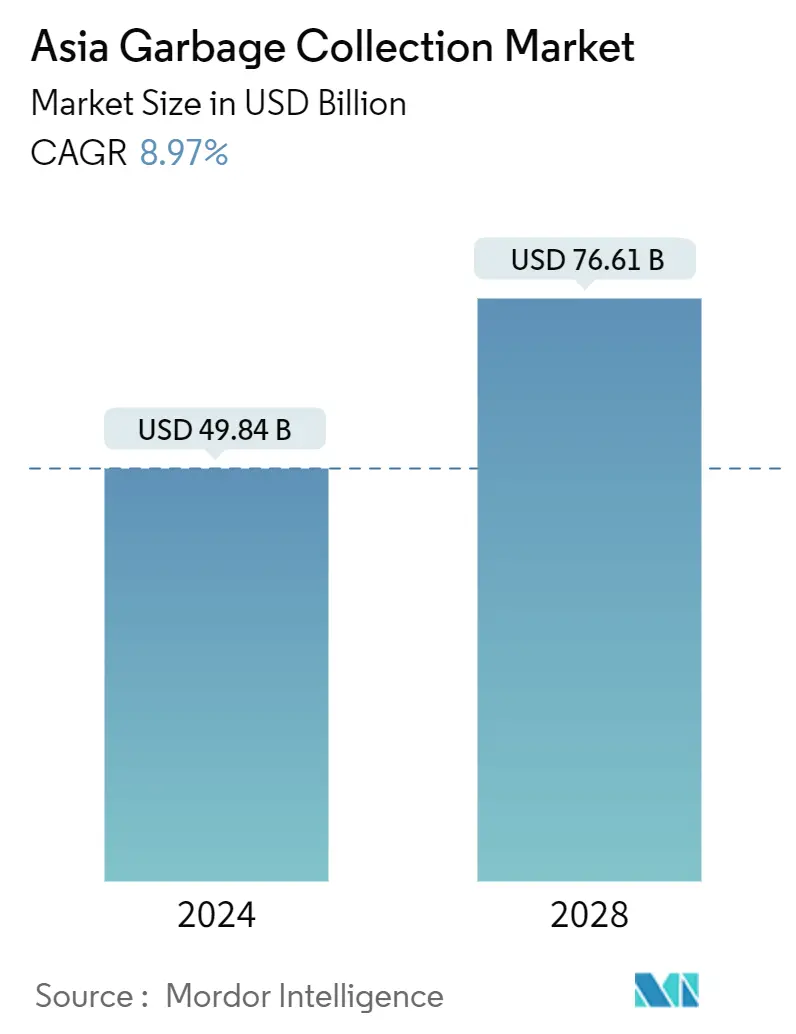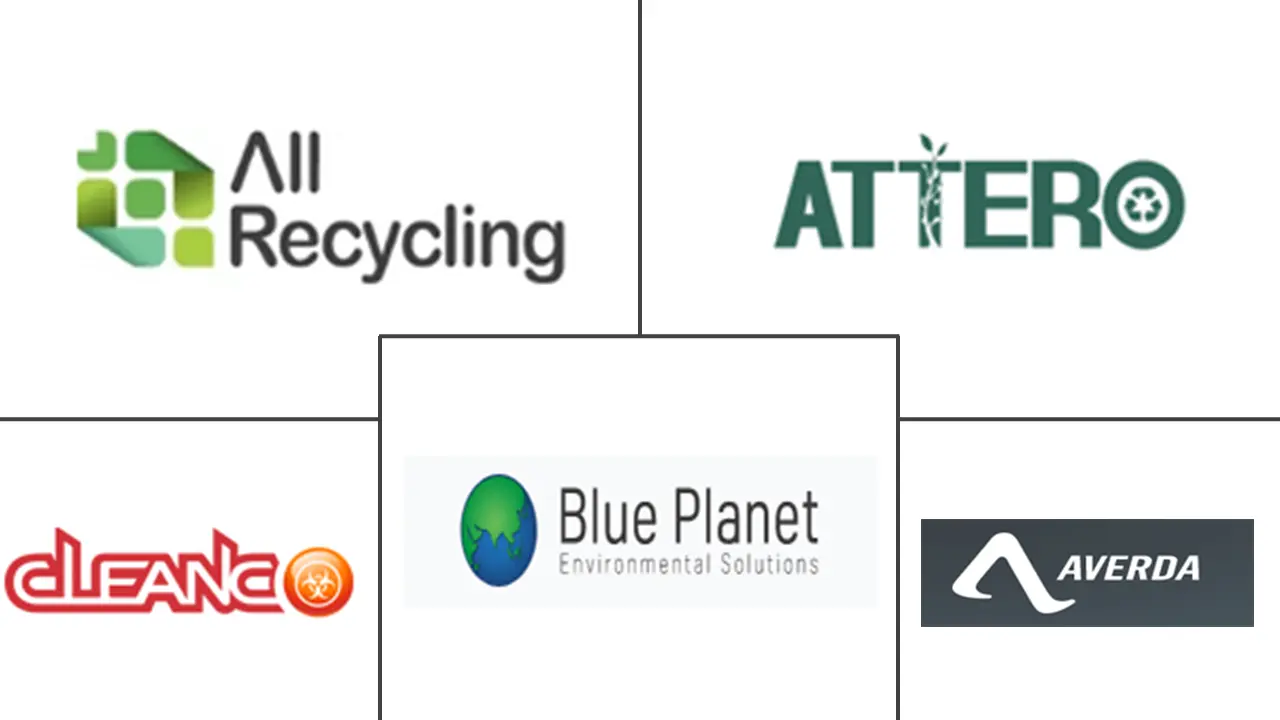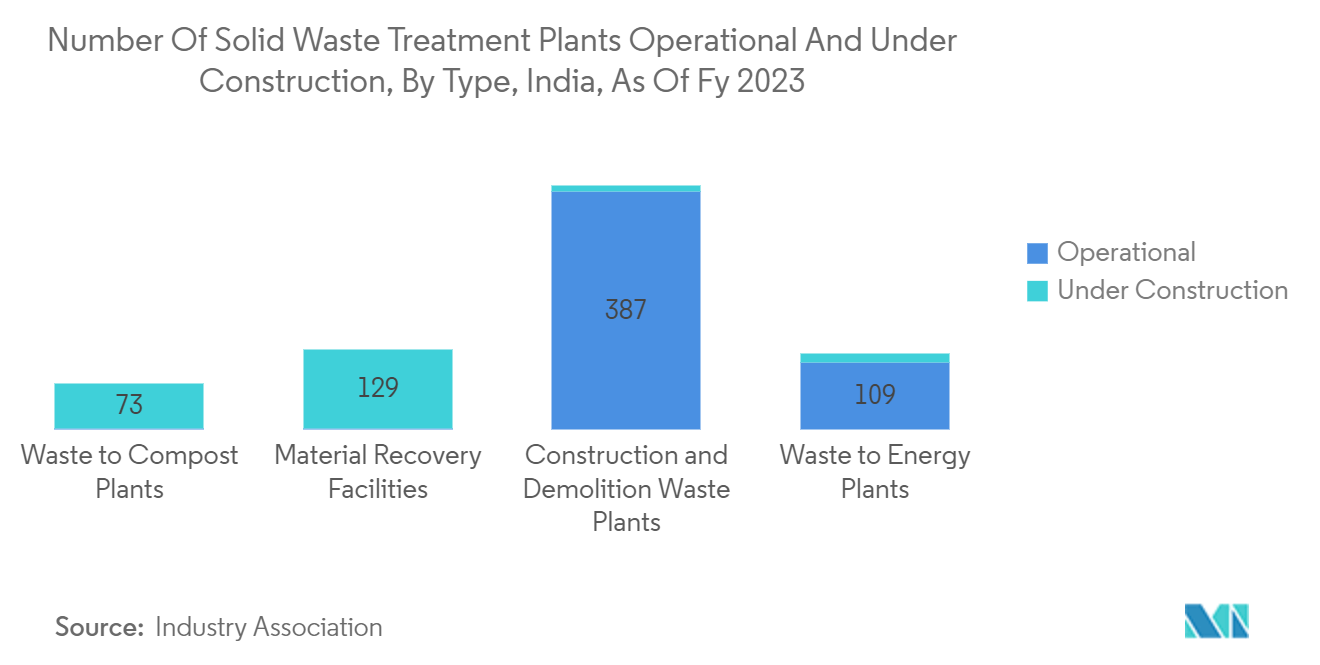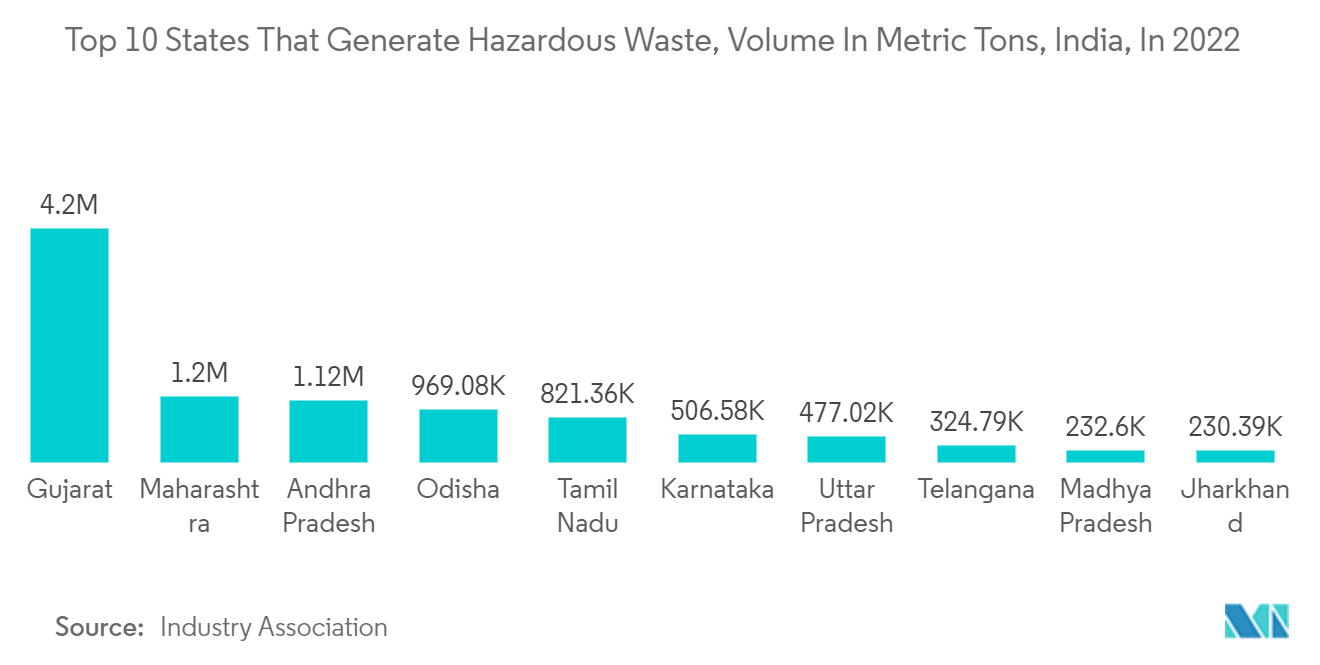Asia Garbage Collection Market Size

| Study Period | 2020-2029 |
| Market Size (2024) | USD 49.84 Billion |
| Market Size (2029) | USD 76.61 Billion |
| CAGR (2024 - 2028) | 8.97 % |
| Fastest Growing Market | Asia |
| Largest Market | North America |
Major Players
*Disclaimer: Major Players sorted in no particular order |
Asia Garbage Collection Market Analysis
The Asia Garbage Collection Market size is estimated at USD 49.84 billion in 2024, and is expected to reach USD 76.61 billion by 2029, growing at a CAGR of 8.97% during the forecast period (2024-2029).
- In Asia, governments and organizations are focusing on developing efficient waste management systems to tackle the challenges of waste disposal and environmental impact. Many countries in Asia are implementing modern waste collection methods, such as waste-to-energy plants and recycling initiatives.
- One of the biggest factors is the rapid population growth and urbanization happening in many Asian countries. As more people move to cities, the amount of waste generated increases significantly. This presents a challenge for governments and local authorities to effectively collect and manage the waste.
- In response to this challenge, many countries in Asia are implementing modern and innovative waste management systems. These systems focus on sustainable practices such as recycling, waste-to-energy conversion, and composting. They aim to reduce the amount of waste going to landfills and minimize the environmental impact.
- Another important factor is the increasing awareness and emphasis on environmental sustainability. People are becoming more conscious about the impact of their waste and are demanding better waste management solutions. This has led to the emergence of recycling programs, waste segregation initiatives, and public awareness campaigns across the region.
- Each country in Asia has its unique approach to garbage collection. For example, in Japan, they have a highly organized waste management system with strict recycling rules. In Singapore, they have implemented a pay-as-you-throw system to encourage waste reduction.
- Overall, the Asia garbage collection market is evolving and adapting to meet the increasing waste management needs of the region. It's an important industry that is continuously working towards sustainable waste management practices.
Asia Garbage Collection Market Trends
Non Hazardous segment dominating the market
- The management of hazardous waste requires specialized knowledge, infrastructure, and regulatory frameworks. In Asia, there is increasing recognition of the need to properly handle and dispose of hazardous waste to prevent detrimental effects on public health and the environment.
- Several factors contribute to the complexity of managing hazardous waste in Asia. Firstly, the rapid industrialization and economic growth in many Asian countries have led to an increase in hazardous waste generation. Industries such as manufacturing, chemicals, and healthcare produce significant amounts of hazardous waste that require proper disposal.
- Secondly, the diversity of hazardous waste materials poses challenges. Hazardous waste can take various forms, including toxic chemicals, flammable substances, radioactive materials, and infectious waste. Each type requires specific handling, treatment, and disposal methods to ensure safety.
- Thirdly, the need for adequate infrastructure and resources for hazardous waste management is a significant challenge in some regions of Asia. Proper storage, transportation, and treatment facilities are essential to handle hazardous waste safely. Some countries in Asia are actively working to improve their infrastructure and establish dedicated hazardous waste management facilities.
- Fourthly, regulatory frameworks and enforcement play a crucial role in managing hazardous waste. Many Asian countries have developed regulations and guidelines to govern the collection, transportation, treatment, and disposal of hazardous waste. Compliance with these regulations is necessary to protect the environment and public health.

Expanding Indian segment
- Waste management is becoming an increasingly important sector in India. The sector is also being supported by growing public awareness and the willingness of more young entrepreneurs to become environmental business owners, as well as favorable government regulations.
- India's population accounts for approximately 18% of the total world population and 12% of global municipal solid waste production. Over the coming decades, India's waste production is expected to grow significantly as a result of an increasing population. Consequently, its management has been made more difficult. In spite of the door-to-door collection of waste in many cities, India's inadequate sorting and disposal facilities make it inefficient.
- In 2016, MoEFCC launched the Integrated Waste Management System to ease waste management and end-to-end apps in line with the government’s attempt to digitize the economy.
- The government launched a Swachh Bharat campaign, which has been spreading all over India to clean streets, roads, and infrastructure in cities, towns, and villages. Since 2014, the mission has been in force for five years. As a result, citizens were encouraged to take part in the waste management solution.
- India has one of the world's biggest landfill sites in Ghazipur, and cities across the country are major contributors to municipal solid waste.
- Due to the government's emphasis on cleanliness and hygiene, India's solid waste management sector has experienced considerable growth over the last few years. The significant increase in waste generation as a result of population growth and rapidly urbanizing has led to an urgent need for effective and lasting waste management practices.
- The government's Swachh Bharat (Abhiyan Clean India Mission) has boosted the sector, leading to a surge in demand for waste management solutions. Increased urbanization, increased awareness about waste management, and growing investments in infrastructure to manage waste are some of the factors driving a market for solid waste management in India.

Asia Garbage Collection Industry Overview
The garbage collection market in Asia is highly competitive, with several players dominating the industry. These companies provide waste management services to residential, commercial, and industrial sectors, ensuring proper collection and disposal of waste.
Asia Garbage Collection Market Leaders
-
All Recycling
-
Attero
-
Averda
-
Blue Plane
-
Cleanco Waste Treatment
*Disclaimer: Major Players sorted in no particular order

Asia Garbage Collection Market News
- September 2023: Project STOP, in collaboration with Regent Ipuk Feliiantiandani, inaugurated one of Indonesia's largest Material Recovery Facilities in Songgon Town. This significant milestone, achieved in partnership with the Banyuwan Provincial Government, marks a major stride toward establishing Indonesia as the pioneer in regency-run systems for circular waste management.
- March 2023: ALBA Group Asia, the premier waste management company and recycling solutions provider for German-owned communities and industries in Vietnam, formalized a cooperation agreement with VietCycle, a leading waste collection company and plastic recycling provider in Vietnam. Together, they are embarking on a joint venture to establish the largest food-grade PET/HDPE plastic recycling facility in Vietnam, showcasing their commitment to sustainable and innovative waste management solutions.
Asia Garbage Collection Market Report - Table of Contents
1. INTRODUCTION
- 1.1 Study Assumptions and Market Definition
- 1.2 Scope of the Study
2. RESEARCH METHODOLOGY
3. EXECUTIVE SUMMARY
4. MARKET DYNAMICS AND INSIGHTS
- 4.1 Market Overview
-
4.2 Market Dynamics
- 4.2.1 Market Drivers
- 4.2.1.1 Increasing awareness among consumers
- 4.2.1.2 Environment concerns and sustainability
- 4.2.2 Market Restraints
- 4.2.2.1 The cost of production and transportation
- 4.2.2.2 Regulations and quality standards
- 4.2.3 Market Opportunities
- 4.2.3.1 The demand for sustainable solutions
- 4.2.3.2 Regional and local market expansion driving the market
-
4.3 Industry Attractiveness - Porter's Five Forces Analysis
- 4.3.1 Bargaining Power of Suppliers
- 4.3.2 Bargaining Power of Buyers
- 4.3.3 Threat of New Entrants
- 4.3.4 Threat of Substitutes
- 4.3.5 Intensity of Competitive Rivalry
5. MARKET SEGMENTATION
-
5.1 By Product Type
- 5.1.1 Waste Disposal Equipment
- 5.1.2 Waste Recycling
- 5.1.3 Sorting Equipment
-
5.2 By Waste Type
- 5.2.1 Hazardous Waste
- 5.2.2 Non-Hazardous Waste
-
5.3 By Collection Type
- 5.3.1 Curbside Pickup
- 5.3.2 Door-to-door Collection
- 5.3.3 Community Recycling Programs
-
5.4 By End User
- 5.4.1 Municipal Waste Management
- 5.4.2 Healthcare
- 5.4.3 Chemical
- 5.4.4 Mining
-
5.5 By Region
- 5.5.1 China
- 5.5.2 Japan
- 5.5.3 India
- 5.5.4 Rest of Asia
6. COMPETITIVE LANDSCAPE
- 6.1 Market Concentration Overview
-
6.2 Company Profiles
- 6.2.1 All Recycling
- 6.2.2 Attero
- 6.2.3 Averda
- 6.2.4 Blue Plane
- 6.2.5 Cleanco Waste Treatment
- 6.2.6 Enviroserve
- 6.2.7 Remondis
- 6.2.8 Se Cure Waste Management
- 6.2.9 SEPCO*
- *List Not Exhaustive
- 6.3 Other Companies (Key Information/Overview)
7. FUTURE OF THE MARKET
8. APPENDIX
** Subject To AvailablityAsia Garbage Collection Industry Segmentation
The garbage collection market refers to the industry involved in collecting, transporting, and disposing of waste materials. It encompasses various activities such as curbside pickup, recycling programs, and waste management technologies. Factors like population growth, urbanization, and environmental regulations drive the market. It plays a crucial role in maintaining cleanliness and sustainability in our communities.
The Asia garbage collection market is segmented by product type, waste type, collection type, end-user, and region. By product type, the market is segmented by waste disposal equipment, waste recycling, and sorting equipment. By waste type, the market is segmented into hazardous waste and non-hazardous waste. By collection type, the market is segmented by curbside pickup, door-to-door collection, and community recycling programs. By end-user, the market is segmented by municipal waste management, healthcare, chemical, mining, etc. By region, the market is segmented by China, Japan, India, and Rest of Asia.
The report offers the market sizes and forecasts for the Asia garbage collection market in value (USD) for all the above segments.
| By Product Type | Waste Disposal Equipment |
| Waste Recycling | |
| Sorting Equipment | |
| By Waste Type | Hazardous Waste |
| Non-Hazardous Waste | |
| By Collection Type | Curbside Pickup |
| Door-to-door Collection | |
| Community Recycling Programs | |
| By End User | Municipal Waste Management |
| Healthcare | |
| Chemical | |
| Mining | |
| By Region | China |
| Japan | |
| India | |
| Rest of Asia |
Asia Garbage Collection Market Research FAQs
How big is the Asia Garbage Collection Market?
The Asia Garbage Collection Market size is expected to reach USD 49.84 billion in 2024 and grow at a CAGR of 8.97% to reach USD 76.61 billion by 2029.
What is the current Asia Garbage Collection Market size?
In 2024, the Asia Garbage Collection Market size is expected to reach USD 49.84 billion.
Who are the key players in Asia Garbage Collection Market?
All Recycling, Attero, Averda, Blue Plane and Cleanco Waste Treatment are the major companies operating in the Asia Garbage Collection Market.
Which is the fastest growing region in Asia Garbage Collection Market?
Asia is estimated to grow at the highest CAGR over the forecast period (2023-2029).
Which region has the biggest share in Asia Garbage Collection Market?
In 2023, the North America accounts for the largest market share in Asia Garbage Collection Market.
What years does this Asia Garbage Collection Market cover, and what was the market size in 2023?
In 2023, the Asia Garbage Collection Market size was estimated at USD 45.37 billion. The report covers the Asia Garbage Collection Market historical market size for years: 2020, 2021, 2022 and 2023. The report also forecasts the Asia Garbage Collection Market size for years: 2024, 2025, 2026, 2027, 2028 and 2029.
Asia Garbage Collection Industry Report
Statistics for the 2024 Asia Garbage Collection market share, size and revenue growth rate, created by Mordor Intelligence™ Industry Reports. Asia Garbage Collection analysis includes a market forecast outlook to for 2024 to 2029 and historical overview. Get a sample of this industry analysis as a free report PDF download.



